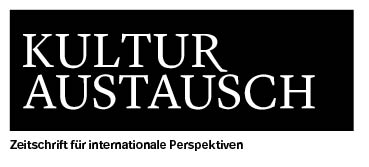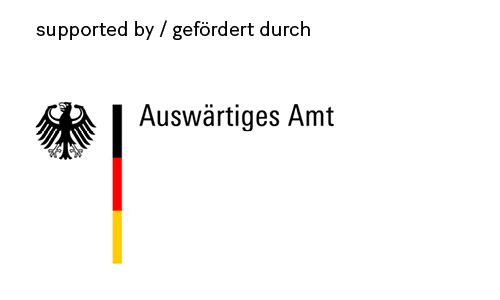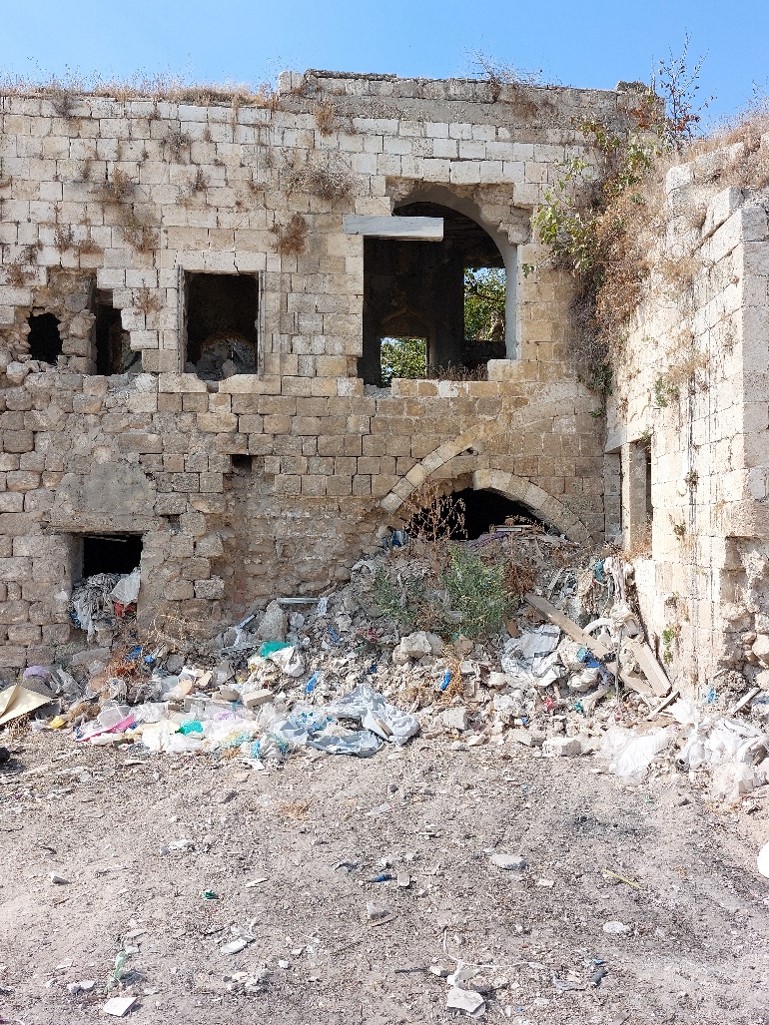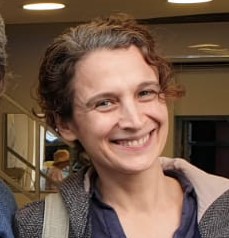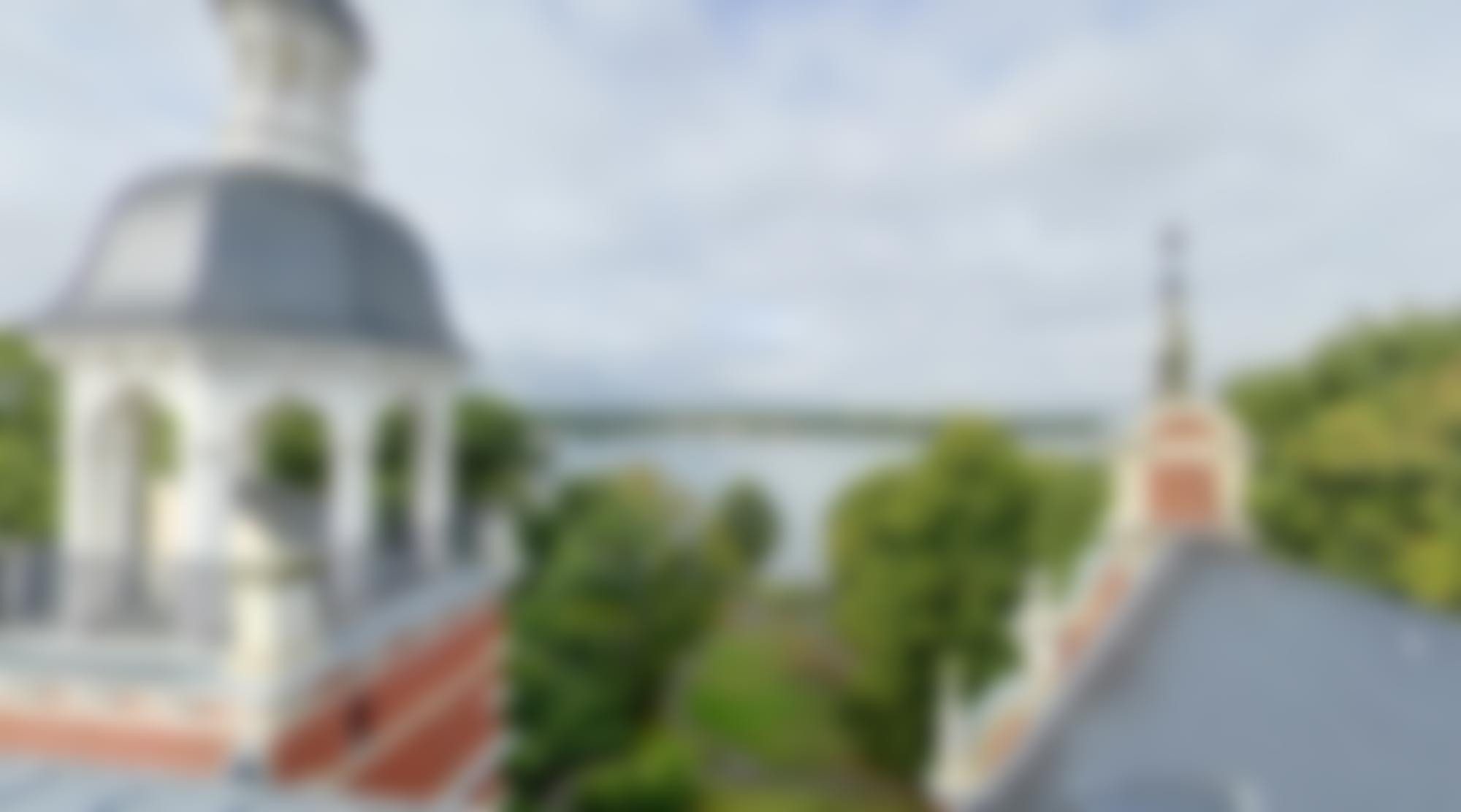התחדשות עירונית, רעידת אדמה וחורבן העבר
המבנה בתמונה, הניצב/מתמוטט בעיר הערבית-יהודית רמלה, הוא שרידיו של בית מידות מפואר שנבנה בתחילת המאה ה-18, בתקופת השלטון העות’מאני בארץ ישראל/פלשתינה. משפחת אבו אל הודא הפלסטינית, מן המשפחות העשירות ברמלה, בנתה את הבית למגוריה ונטעה גן גדול לצדו. סגנונו של המבנה היה אופייני לבנייה המוסלמית בת התקופה: כיפה על הגג ועליה עיטור סהר, אבני חול צבעוניות, קשתות מוריות וקישוטי אבלאק ונטיפות. כיום עומד המבנה, ריק וחרב, בלב מגרש חנייה ומתפורר לאטו בחזרה אל אדמת החול שהעניקה לעיר רמלה את שמה (ר’מל, رمل, בערבית = חול) בתקופת השלטון הערבי בראשית המאה ה-8. ערמות האשפה מן החנויות והסדנאות הסמוכות מצטברות סביבו, וצחנה ונחילי זבובים סובבים אותו. הרשויות הניחו מצדו האחד של המבנה שלט האוסר על זריקת אשפה ומצדו האחר הציבו שתי מכולות זבל ענקיות. אבל ערמת האשפה גובהת משנה לשנה. הגן הגדול שעמד מצדו המזרחי של הבית ומבנים נוספים שעמדו מצדו המערבי שוטחו מזמן. הנחלה משמשת היום כמגרש חנייה, שכנציג נאמן של פרקטיקה עירונית ידועה ומניבת רווחים משגיח שהשטח העירוני לא ינוצל ומחכה בכניעה ליום שבו מחירי הנדל“ן באזור יעלו והארמון העות’מאני המתפורר יהיה שוב לחול ואבק. אז יתאחד עמו לכדי שממה חרבה הנכונה ל“התחדשות העירונית“.
לשם כך לא נחוץ דבר מלבד זמן. שכן מבנים כאלה כפופים לחוקי שימור רפויים ואינם מוגנים על ידי חוק כלשהו, מלבד האיסור להורסם. מנגד, הם מוגנים על ידי חוק אחר – חוק נכסי נפקדים, שנחקק ב-1950 ומתיר למדינה להפקיע באופן זמני את כל נכסיהם של מי שעזבו את ביתם בזמן מלחמת 1948 ועברו למדינות אויב (כלומר מדינות ערב). מאחר שביולי 1948 כבש הצבא הישראלי את העיר רמלה ותושביה הערבים נצטוו להתפנות ממנה, נותרה הקרקע של בני אבו אל הודא נטושה והועברה לרשותה של חברת השיכון הממשלתית, עמידר (האם יש טעם לשאול איזה עם?), המטפחת שאיפות משלה בנוגע לקרקע. בינתיים מציית המבנה בעיקר לחוק היסטוריית הטבע של ההרס. עברו העות’מאני של המבנה אינו מסייע לו – נהפוך הוא. ואין זה שאיננו משמרים חורבות עתיקות בישראל – אדרבה, שרידים של ציוויליזציות שוקעות, כגון האימפריה הרומית, הביזנטית, אפילו הממלוכית והעבאסית, שלא לדבר על התקופה המקראית, נשמרים ומפוקחים היטב, ודמי כניסה נאים נגבים בכניסה אליהם כדי לכסות על עלויות תחזוקתם. עשרות שרידים עות’מאניים הקשורים לתולדות הציונות עוברים שימור קפדני, אך עתיקות מסוג זה, מן הסוג המעיד על הקונפליקט הישראלי-פלסטיני, פחות אהודות על הרשויות. גם כשמשמרים אותן הן אינן הופכות למוזיאונים ולמרכזי מורשת ואינן שומרות על צביונן המקורי – אלא מוסוות כמלונות בוטיק ומרכזי קניות. אבל לרוב הן פשוט מופקרות לגורלן. מה גם שבערים שהן ממוקמות בהן שוכנת בדרך כלל אוכלוסייה גדולה יחסית של פלסטינים-ישראלים, שעלולה להרגיש זיקה אליהם. הערים העתיקות והדו-לאומיות לוד, רמלה, יפו, עכו, חיפה, באר שבע, מנוקדות במבנים כאלה, מין פסיקים היסטוריים מבודדים בלב נרטיב הקדמה המשוטח שמסביבן.
אך לפעמים פוקעת סבלנותה של האדמה עצמה והיא מתקוממת על הגבולות המדיניים ועל מפעלי האדם. רעידת האדמה הגדולה שהתחוללה בשנת 1927 במזרח התיכון, החריבה בתי מגורים רבים באזור, בין השאר בערים רמלה ולוד, וערערה את המרקם העירוני שהתקיים בהן. השלטון הבריטי בפלשתינה דאז השכיל לנצל זאת כדי להזניח את אזור המגורים הצפוף וההרוס למחצה במשך עשרים השנים הבאות ולהשלים כך את מגמת ההשטחה וההרחבה של ארץ הקודש לכדי מרחב ההולם את החזון האוריינטליסטי של „נוף קדומים“. רעידת האדמה האחרונה שהכתה בסוריה ובטורקיה היא אולי תזכורת לאותה התפרצות זעם גיאולוגית. אך נדמה שלא למדנו דבר. גם היום המשטרים האזוריים ששים עדיין – בחסות אסונות טבע ואיומי מלחמה – לקדם מפעלי בנייה מופרכים, הנענים בראש ובראשונה לאינטרסים כלכליים. האם אותן מפלצות בטון בעלות יסודות מוצקים אכן נענות לאתגרי החיים על אדמתנו הבוגדנית?
בשכונה הצפונית שבה אני גרה בתל אביב נהרס מדי כמה ימים עוד בניין המיועד להתחדשות עירונית. אפילו בשלוש השנים האחרונות – כשנדמה היה כי העולם עומד מלכת – לא פסקה תכונת ההרס והבנייה. בימים שבהם הסתגרו בביתם בני המזל שברשותם בית העומד על תלו נדמה היה לפעמים שרק פועלי הבניין – פלסטינים מן הגדה המערבית, אולי בני משפחות שגורשו מרמלה ולוד בשנת 1948 – נראים ברחוב, בבגדיהם המלוכלכים ובפניהם המוכתמות באבק טיח, בונים בימים את בתי העם האחר, ובלילות – מפאת הסגרים (סגרי מגפה, סגרי גבול) ישנים בין חצאי קירותיהם. רוח הרפאים של הבתים הנהרסים שוב ושוב בכפרים הערבים הלא מוכרים מרחפת מעל הפיגומים. גם תל אביב נבנתה על חולות – אך שלא כמו החורבה העות’מאנית ברמלה, הנאחזת בקרקע, בתיה של תל אביב קורסים ונבנים, קורסים ונבנים, וממלאים את האוויר בערפל של חול ואבק בטרם יצמחו מחדש מאפרם כבונקרים יוקרתיים מעוטרים בגינות בטון.
זה שנים שאנחנו מתנהלים בתוך הערפיח הזה, הפוליטי, הכלכלי, החברתי, שהוא רוח התקופה. אילו היה מתפוגג מעט, אולי היינו יכולים לראות מבעדו את פניו המבועתים של מלאך ההיסטוריה של ולטר בנימין, גבו אל רמלה החרבה ופניו אל תל אביב-יפו הנבנית.
Stadterneuerung, Erdbeben und die Zerstörung der Vergangenheit
Das Gebäude auf der Abbildung, das in der arabisch-jüdischen Stadt Ramla steht/zerfällt, ist der Überrest eines prachtvollen Gebäudes, das Anfang des 18. Jahrhunderts, zur Zeit der osmanischen Herrschaft in der Region, die heute Israel/Palästina genannt wird, erbaut wurde. Die palästinensische Familie Abu al Huda, eine der wohlhabendsten Familien in Ramla, baute dieses Haus als Wohnsitz und legte daneben einen großen Garten an. Der Baustil ist typisch für die muslimische Bauweise jener Zeit: ein Kuppeldach, das mit einem Halbmond geschmückt ist, bunte Sandsteine, maurische Bögen, verziert mit Muqarnas und Ablaqtechnik. Heute steht das Gebäude, verlassen und zerstört, in der Mitte eines Parkplatzes und zerbröselt langsam wieder zu dem Sandboden, der der Stadt Ramla zur Zeit der arabischen Herrschaft, Anfang des 8. Jahrhunderts, ihren Namen gegeben hat (Ramil, رمل im Arabischen: Sand). Die Müllberge aus den umliegenden Geschäften und Werkstätten türmen sich um das Gebäude, Gestank und Fliegenschwärme umgeben es. Die Behörden haben auf der einen Seite ein Schild angebracht, das das Abladen von Müll verbietet und auf der anderen Seite zwei riesige Müllcontainer aufgestellt. Aber der Müllhaufen wird jedes Jahr nur noch höher. Der große Garten an der östlichen Seite des Hauses sowie andere Gebäude, die daneben standen, wurden schon vor langer Zeit eingeebnet. Das Grundstück wird heute als Parkplatz genutzt, der als treuer Vertreter einer gängigen, gewinnorientierten städtischen Vorgehensweise darauf acht gibt, dass das städtische Gebiet nicht genutzt wird. Geduldig wartet es auf den Tag, an dem die Immobilienpreise in der Gegend steigen und das zerbröselnde osmanische Schloss wieder zu Sand und Staub wird. Dann werden sich Schloss und Parkplatz in einer einzigen trostlosen Wüste vereinen, bereit für die „Stadterneuerung“.
Daher benötigt man nichts weiter als Zeit. Denn solche Gebäude unterstehen Denkmalschutzgesetzen, die sie nicht weiter schützen, als vor dem Abriss zu bewahren. Dahingegen sind sie durch ein anderes Gesetz geschützt – das „Gesetz über das Eigentum von Abwesenden“, welches 1950 erlassen wurde und dem Staat ermöglicht, temporär alle Grundstücke derjenigen, die ihre Häuser während des Krieges 1948 verließen und in feindliche (also arabische) Länder übersiedelten, zu konfiszieren. Da das israelische Militär im Juli 1948 die Stadt Ramla besetzte und ihren arabischen Einwohnern befahl, die Stadt zu verlassen, blieb das Grundstück der Familie Abu al Huda verlassen zurück. Es wurde in den Zuständigkeitsbereich des israelischen staatlichen Wohnungsbauunternehmen Amidar – im Deutschen: „Mein Volk wohnt“ (Macht es überhaupt Sinn, zu fragen, um welches Volk es sich handelt?) übergeben, die wiederum ihre eigenen Ambitionen bezüglich der Grundstücke hat. In der Zwischenzeit folgt das Gebäude vor allem dem Gesetz der Naturgeschichte der Zerstörung. Seine osmanische Vergangenheit nützt ihm nicht – im Gegenteil. Es ist nicht so, dass man antike Ruinen in Israel nicht erhalten würde – In der Tat werden Überreste vergangener Zivilisationen, wie des Römischen und des Byzantinischen Reiches, ja sogar des Mamlukischen und des Abbasiden Reiches – ganz zu schweigen von den Überresten aus der biblischen Zeit – sehr sorgfältig gepflegt und erhalten. Mit stolzen Eintrittspreisen deckt man die Kosten für Erhalt und Pflege. Dutzende osmanische Ruinen, die mit der zionistischen Geschichte verbunden sind, werden penibel erhalten, jedoch Antiquitäten dieser Art, welche vom israelisch-palästinensischen Konflikt zeugen, sind bei den Behörden weniger beliebt. Wenn man sie doch erhält, werden sie nicht zu Museen und Zentren des Vermächtnisses und man bewahrt nicht ihren ursprünglichen Charakter – sondern sie werden als Boutique-Hotels und Einkaufszentren getarnt. Meistens jedoch werden sie ihrem Schicksal überlassen. Zumal sie häufig in Städten mit einer großen palästinensischen/arabischen-israelischen Bevölkerung stehen, die einen unerwünschten Bezug zu den Gebäuden empfinden könnte. In den binationalen antiken Städte wie Lod, Ramla, Jaffa, Haifa und Beer Sheva stehen derlei Gebäude getüpfelt, wie vereinzelte historische Kommata im Herzen des abgeflachten Fortschrittsnarrativs, das sie umgibt.
Manchmal aber verliert der Boden selbst die Geduld und sträubt sich gegen die politischen Grenzen und das menschliche Handeln. Das große Erdbeben, das sich 1927 im Nahen Osten ereignete, zerstörte viele Wohnhäuser, einschließlich in Ramla und Lod, und mit ihnen das lebendige städtische Gefüge in ihnen. Die damalige britische Regierung in Palästina unternahm keinen Wiederaufbau, sondern ließ das Wohngebiets zerfallen, um den Trend der Einebnung und Erweiterung des Heiligen Landes zu vollenden – damit es ihrer orientalischen Vision der Urlandschaft entspräche, und dabei der modernen Überwachungspraxis besser diene. Das Erdbeben, das gerade die Türkei und Syrien traf, ist womöglich eine Mahnung des immer drohenden geologischen Wutausbruchs. Es scheint jedoch, dass wir daraus keine Lektion gelernt haben. Die regionalen Regimes – unter dem Vorwand von Naturkatastrophen und Raketenangriffen – freuen sich auch heute, absurde Bauinitiativen zu fördern, die vor allem wirtschaftlichen Interessen folgen. Aber können diese mit soliden Fundamenten ausgestatteten Betonmonster den Lebensherausforderungen unserem tückischen Boden standhalten?
Im Norden Tel Avivs, in dem Viertel, in dem ich lebe, werden alle paar Tage Gebäude zum Zweck der „Stadterneuerung“ abgerissen. Nicht einmal während der letzten drei Jahre – als man dachte, die Pandemie würde die Welt anhalten – wurden der Abriss- und Baurummel eingestellt. Zu der Zeit, als sich diejenigen, die sich glücklich schätzen konnten, in einem fest auf dem Boden stehenden Heim zu wohnen, sich in ihren Häusern verbargen, schien es manchmal so, als sähe man auf der Straße nur die Bauarbeiter – Palästinenser aus der Westbank, womöglich Verwandte der 1948 aus Ramla und Lod vertriebenen Familien – in ihrer mit Baustaub verdreckten Kleidung und verschmutzten Gesichtern, die nun tagsüber die Häuser eines anderen Volkes bauten und die Nächte – aufgrund von Lockdown oder Sperrungen des Grenzübergangs – in deren halbfertigen Wohnungen verbrachten. Das Gespenst der abgerissenen Gebäude und der immer wieder zerstörten, nicht anerkannten arabischen Dörfer, geistert um die Baugerüste.
Tel Aviv wurde auch auf Sand gebaut – aber im Gegensatz zu der osmanischen Ruine in Ramla, die sich am Boden festklammert, stürzen die Häuser der neuen Städte Israels ein und werden immer wieder neu gebaut. Die Luft füllt sich mit Sand und Staub, bevor sie als Luxusbunker, verziert mit Betongärten, von Neuem aus der Asche auferstehen.
Seit Jahren befinden wir uns in diesem politischen, wirtschaftlichen und gesellschaftlichen Smog, der Zeitgeist ist. Wenn er sich langsam legen würde, könnten wir vielleicht das erschrockene Gesicht Walter Benjamins Engel der Geschichte sehen, mit dem Rücken dem zerstörten Ramla und dem Gesicht dem gebaut werdenden Tel Aviv zugewandt.
Übersetzung: Michal Bondy
Urban Renewal, Earthquake and Destruction of the Past
The building featured in the picture, standing/collapsing in the Arab-Jewish city of Ramla, is what remains of a magnificent mansion built at the beginning of the 18th century, during the Ottoman rule of the Land of Israel/Palestine. The Palestinian Abu al-Huda family, one of the wealthiest families in Ramla, built the house to reside in, and planted a large garden by its side. The style of the building was characteristic of the Muslim architecture of the time: a dome on the roof with a crescent-shaped ornament, colorful sandstones, Moorish arches and Ablaq decorations and pendants. Nowadays, the building remains standing, desolate and destroyed, in the heart of a parking lot, slowly crumbling back into the sand soil after which Ramla was named (R’mel, رمل, in Arabic = sand) in the era of the Arab rule during the early eighth century. Piles of trash from the adjacent shops and workshops are accumulating around it, a stench and swarms of flies encircle it. On one side of the structure, the authorities have placed a sign forbidding the dumping of trash, while on the other side they’ve placed two huge garbage containers. But the pile of trash just keeps growing every year. The large garden which used to spread out to the east of the house, and additional buildings which stood to its west, were flattened long ago. The property is currently used as a parking lot, which as a loyal agent of this renowned and revenue-generating municipal practice ensures that the public space isn’t utilized, awaiting in submission for the day when real estate prices in the area rise and the disintegrating Ottoman palace is transformed back into sand and dust. Then, it will reunite with them and become ruined wasteland ready for “urban renewal”.
This requires nothing but time. Structures such as these are subject to flimsy conservation laws, and are not protected by any law apart from the law that prohibits them from being torn down. On the other hand, they are protected by another law – the Absentee Property Law which was legislated in 1950 and permits the country to temporarily confiscate all properties of people that left their homes during the 1948 war and moved to enemy countries (in other words, Arab countries). Given that the Israeli army captured the city of Ramla in July 1948, and its Arab residents were ordered to vacate it, the land belonging to the Abu al-Huda family remained abandoned and was reassigned to the possession of the government housing company, Amidar (”My nation resides” in Hebrew – is there any point in asking which nation they mean?), which promotes its own aspirations regarding the land. Meanwhile, the building has mainly been obeying the natural law of destruction. Its Ottoman past hasn’t been helpful – on the contrary. And it’s not like we don’t preserve ancient ruins in Israel. As a matter of fact, remnants of sinking civilizations, such as the Roman and Byzantine, and even the Mamluk and Abbasid empires, not to mention the Biblical era, are well preserved and supervised, and hefty sums are collected upon entry to these places in order to cover their maintenance expenses. Dozens of Ottoman remains related to the history of Zionism undergo meticulous conservation processes, however ruins such as this, the kind that serve as a testament of the Israeli-Palestinian conflict, are less popular amongst the authorities. Even when they are conserved, they are not turned into museums and heritage centers and do not maintain their original nature – but are rather camouflaged as boutique hotels and shopping centers. But for the most part, they are just left to their own fate. Moreover, they are usually located in cities with large populations of Israeli-Palestinians, which may have a questionable affinity for them. The ancient and binational cities of Lod, Ramla, Jaffa, Acre, Haifa, Beer Sheva, are dotted with such buildings, almost like isolated historical punctuation marks in the heart of the flattened narrative of progress surrounding them.
Yet, sometimes the earth itself loses its patience and rebels against the political borders and human ventures. The large earthquake that occurred in 1927 throughout the Middle East destroyed many residential buildings in the area, including in the cities of Ramla and Lod, destabilizing their urban fabric. At that time, the British mandate in Palestine cleverly exploited this event in order to neglect the dense and semi-destructed residential area for the following twenty years, thus completing the course of flattening and expanding of the Holy Land into a region that aligns with the Orientalist vision of a “pristine ancient landscape”. The recent earthquake that struck Syria and Turkey is perhaps a reminder of the eruption of that geological rage. But it seems that we have learned nothing. Even today local governments are still eager –under the auspices of natural disasters and threats of war – to promote far-fetched construction ventures, which respond first and foremost to financial interests. Do those concrete monstrosities with their solid foundations actually meet the life challenges of our disloyal land?
In the northern neighborhood of Tel-Aviv where I live, every few days another building designated for urban renewal is destroyed. Even during the last three years – when it seemed that the world stood still – the bustle of destruction and construction did not cease. While the ones lucky enough to have a standing house stayed indoors, it seemed like only the construction workers – Palestinians from the West Bank, possibly descendants of those who were expelled from Ramla and Lod in 1948 – could be seen on the streets, in their dirty clothes, faces covered in plaster dust, building homes for the other nation during the day, and at night – due to the lockdowns (pandemic lockdowns, border lockdowns) sleeping between their half-walls. The specter of the houses being constantly torn down in unrecognized Arab villages haunts the scaffoldings. Tel-Aviv was also built on sand – however, unlike the Ottoman ruin in Ramla, which clings to the earth, Tel-Aviv’s buildings repeatedly collapse and are rebuilt, filling the air with haze of sand and dust before reemerging from their ash as luxurious bunkers adorned with concrete gardens.
We’ve been conducting our lives within this political, financial and social smog for years now, the smog which is our zeitgeist. If only it would disperse a bit, perhaps we could see through it the terrified face of Walter Benjamin’s angel of history, with his back to the ruined Ramla and his face towards Tel-Aviv of the future.
Translation: Sharon Gesthalter
Teilen







